These wood species are available for use in making most items. Reach out to discuss using these hardwoods for charcuterie boards, cutting boards, boxes, and other items.
Domestic Hardwoods
- Cherry
- Hickory
- Mahogany
- Maple (Soft, hard, curly, ambrosia, birdseye)
- Oak (white and red)
- Orange Osage
- Walnut
Exotic Hardwoods
- Bloodwood
- Canarywood
- Jatoba
- Leopardwood
- Padauk
- Purpleheart
- Wenge
- Yellowheart
- Zebrawood
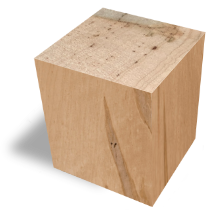
ORIGIN: NORTH AMERICA
The Ambrosia Beetle is an insect that bores into trees and leaves behind a fungus which gives the Ambrosia Maple its unique appearance. Ambrosia Maple is not a distinct species of Maple; as is the case with Curly Maple or Spalted Maple.
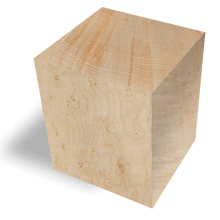
ORIGIN: CANADA AND USA
Birdseye maple is a rare and mysterious characteristic found in hard maple. There have been theories as to how Birdseye maple forms, but no scientific evidence has been presented to verify the true roots of its existence. The one-of-a-kind figure is sought after in all cultures by a multitude of woodworkers, craftsman, and artists. Birdseye maple is excellent for custom pool cues, musical instruments, furniture, and small items such as jewelry boxes due to its unique and amazing figure.
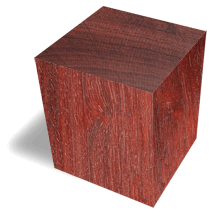
ORIGIN: SOUTH AMERICA
Bloodwood is an exotic wood that is sometimes referred to as cardinal wood, for its obvious beautiful deep rose color. With age its color does darken, but not significantly so it is a great wood to use in intarsia projects. The wood is very dense, with a tight fine, mostly linear grain.
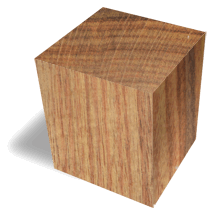
ORIGIN: SOUTH AMERICA
Canarywood is an exotic wood that is yellow to orange in color, typically variegated with light to dark red streaking. It has a medium to high luster. It can be somewhat variable in density, it is mostly a hard, heavy, and strong wood. Works very easily with both hand and power tools and finishes very smoothly. An exceptional exotic wood from South America.
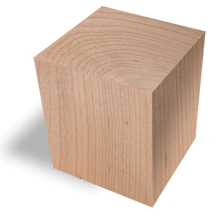
ORIGIN: NORTH AMERICA
American Black cherry is a domestic wood that is usually considered to be in the same class as mahogany for usage in the United States. It is described as wood for fine furniture. The stiff and strong wood is reported to work easily with both hand and machine tools. European and American black cherries are reported to be comparable in many aspects, but the latter is more plentiful. Both species are reported to be strong and tough and have been compared in strength properties to Yellow birch, and compares favorably with Teak.
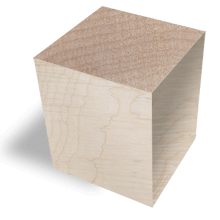
ORIGIN: NORTH AMERICA
Curly Soft maple is only slightly softer than Hard maple. Soft maple often has better color and a more interesting grain pattern. It is an excellent wood for many woodworking projects, including: Musical instruments, furniture, flooring, joinery, and figured decorative veneers.
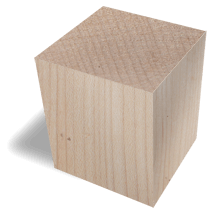
ORIGIN: NORTH AMERICA
The hard maple is the state tree of Wisconsin, Vermont, New York, and West Virginia. In the North, during the cold nights and warm days of late winter, the sugar maple is tapped for its sucrose-containing sap, the source of maple syrup. Until the turn of the century, the heels of women’s shoes were made from maple. Maple has been a favorite of American furniture makers since the early Colonial days.
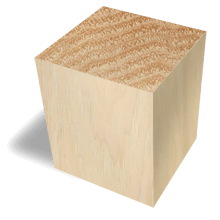
ORIGIN: CANADA AND USA
Hickory is very dense and has good shock resistance and steam-bending properties. Sands, turns, stains, and polishes well.
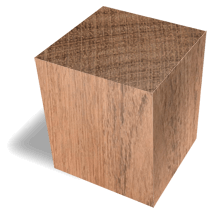
ORIGIN: SOUTH/CENTRAL AMERICA
Jatoba is an exotic wood that runs from salmon-red to orange-brown. It darkens into a russet to reddish-brown color after drying, and it is frequently marked with dark streaks. It is reported to have good strength qualities and can be used in structural applications for which Oak would be suitable. It is reported to be similar to the African species, Tchitola, Black locust, and is superior to White oak.
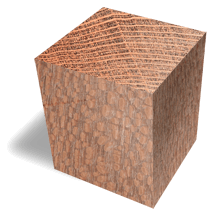
ORIGIN: SOUTH AMERICA
Leopardwood is an exotic wood with dark reddish-brown color with strong broad rays. This material is straight-grained with a medium texture. The highly flecked decorative surface makes this wood ideal for furniture and accent work.
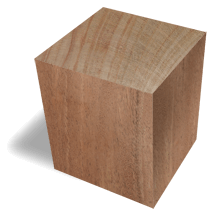
ORIGIN: CENTRAL AND EAST AFRICA
African Mahogany is an exotic wood with a deep reddish brown color. The grain can be straight but is typically interlocking. Working this wood is generally easy but tearing can occur when planing. It often has a shimmering figure. African Mahogany is popular for furniture, cabinetry, joinery, boat building, and veneers.
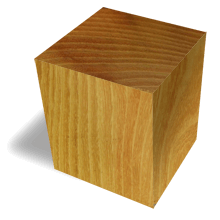
ORIGIN: NORTH AMERICA
Osage Orange (American) is a lighter color of Orange than the darker Argentine type. It has a brighter yellow appearance which oxidizes to a dark brown. Osage Orange can be quite difficult to work with due to its density but, is quite strong and works well in bow construction.
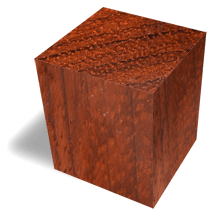
ORIGIN: WEST AFRICA
Padauk is an exotic wood that is a bright orange or almost crimson wood when freshly cut but oxidizes to a darker, rich purple-brown over time – although it stays redder than Indian Rosewood. Slightly harder and heavier than Indian Rosewood it is a good wood in all respects – stable, and easy to work with. It often grows in small groups and is reported to be common in dense equatorial rainforests.
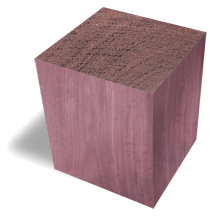
ORIGIN: CENTRAL AND SOUTH AMERICA
Purpleheart is an exotic wood with mechanical properties of the wood are reported to lie somewhere between those of Greenheart and Oak. It is reported to have exceptional tolerance for shock loading. Purpleheart is reported to be highly desired by hobbyists and craftsmen who use the hard heavy wood in small projects.
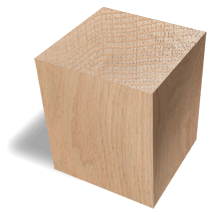
ORIGIN: NORTH AMERICA
Oak is regarded as one of the most beautiful woods to work with because of its grain pattern and character. Oak is used in many woodworking applications, including steam bending. Air-dry bending and crushing strengths are high. Hardness is rated as medium, and weight is high.
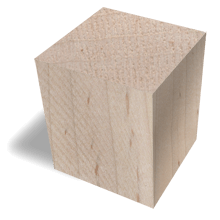
ORIGIN: NORTH AMERICA
Soft maple is only slightly softer than hard, sugar maple. It is similar to Cherry and Walnut in terms of hardness. Soft maple is an excellent wood for many woodworking projects, including: Musical instruments, furniture, flooring, joinery, and cabinetry.
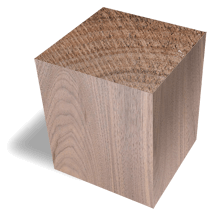
ORIGIN: NORTH AMERICA
Walnut is an all-around popular choice for woodworking. It has a fine texture and works extremely well with hand and power tools. Walnut is prized for use in furniture, cabinets, cutting boards, gunstocks, and a multitude of other projects. It is a popular choice for turning and carving as well.
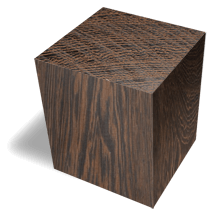
ORIGIN: AFRICA
Wenge is an exotic wood with a natural growth range of the species is reported to be the open forests of Zaire, Cameroon, Gabon, the southern regions of Tanzania, and Mozambique. It is also found in the swampy forests of the Congo region. Wenge is reported to be a suitable substitute for Hickory for the production of sporting goods. It is moderately hard and resistant to wearing and marring. Strength qualities in compression parallel to grain are exceptionally high.
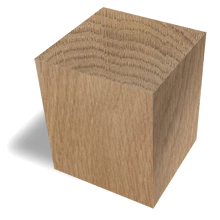
ORIGIN: NORTH AMERICA
Oak is regarded as one of the most beautiful woods to work with because of its grain pattern and character. Oak is used in many woodworking applications, including steam bending. Air-dry bending and crushing strengths are high. Hardness is rated as medium, and weight is high.
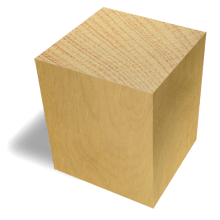
ORIGIN: SOUTH AMERICA
Yellowheart, an exotic wood also called Pau Amarello, can grow to more than 130 feet tall and 30″ in diameter. It has large leaves upwards of 10″ long and 4″ wide. It has a wonderful show of creamy white, fragrant flowers. Pau Amarello trees are found almost exclusively in the State of Para, Brazil. Dust from pau amarello or yellowheart can cause skin rashes so take proper care if you have a sensitivity.
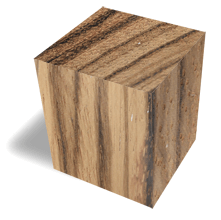
ORIGIN: WESTERN AFRICA
Zebrawood is an exotic wood native to the Western African countries of Cameroon and Gabon. It is a hard wood, with a medium to coarse texture. The Zebra-like appearance is due to the light-colored sapwood in contrast with the dark-colored grain. Zebrawood is excellent for wood turning, veneer, furniture, pens, and knife handles. It works and finishes fairly, and has good gluing properties.
* Descriptions and images come from Bell Forest Products
